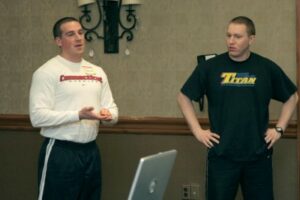
Fitness Business Entrepreneurship Thoughts: Opportunity Cost
As I noted in my post on Cressey Sports Performance’s 10th anniversary, I wanted to use the next few days to outline a few thoughts on the entrepreneurial side of fitness over the next few days. They’ll be quick ones – just a few paragraphs each – but hopefully impactful for those of you interested in the business of fitness.
To kick things off, I’ll talk about opportunity cost, a concept that is actually remarkably applicable to all industries, not just fitness. Briefly, dictionary.com defines opportunity cost as “the money or other benefits lost when pursuing a particular course of action instead of a mutually-exclusive alternative.”
It’s probably best explained with an example. If you go on vacation, the opportunity cost of that time is continuing to work. You leave town and spend a bunch of money on flights, hotels, and touristy things – all while forgoing income at work during that time period. Most people only consider what they spend on the vacation, but your opportunity cost is that lost income. It might also be experiences that you could have had during that time you’re vacationing.
To be clear, I’m not saying that you should skip all your vacations and just work all the time. I’m just saying that absolutely everything in life has an opportunity cost. The opportunity cost of the coffee I’m drinking as I type this could be a glass of water or tea.
Early in your career, the opportunity cost of your time is far less expansive. You need to make money and build your reputation, so you should take on just about every client and continuing education opportunity that comes your way. And, if you want to be successful in writing and speaking, too, then you need to write and speak at every opportunity, even if nobody is or reading listening. The opportunity cost of your time is basically just watching the same episode of Sportscenter for the 47th time.
Having spent two years at business school before transferring into an exercise science program, opportunity cost was something of which I was keenly aware of at a young age. With that in mind, during my undergraduate and graduate years, I worked like a dog. I eschewed a social life in order to pick up every hour at the gym I could and do as much reading and writing as I possibly could. This tradeoff proved to be wildly important, as it helped me to build invaluable career capital and financial stability that opened many more doors for me down the road. As an example, I took time off from work, paid for a hotel room, traveled to Washington, DC, and spoke for free at this event in 2006 – and it proved to be a huge boost for my career.
Now, many years later, I have harder opportunity cost decisions. In the past week, I’ve gotten invited to speak in China, Brazil, Poland, and Minnesota. Each one of these poses different travel demands and compensation scenarios that all need to be weighed against time with family, hours coaching at CSP, what I could earn devoting that time somewhere else, and the impact I could have in other capacities. Eleven years after speaking at that DC event, there really isn’t any circumstance under which I’d take that particular gig again.
A seminar halfway around the world would have been an instant “yes” in 2007, but now, it requires 18 months of planning and time away from family that I’m reluctant to take on. And, I’ve turned down multiple jobs in collegiate and professional sports over the past few years that would have been absolute dream jobs ten years ago. The “dream” changed – and it happened far faster than I could have ever imagined.
With all that in mind, here are three important takeaways from today’s post:
1. [bctt tweet=”Good decisions when opportunity cost is low set the stage for high opportunity cost choices later.”]
2. [bctt tweet=”Say ‘yes’ a lot when young and building a career. Say ‘no’ more than ‘yes’ once more established.”]
3. [bctt tweet=”Before you say ‘no’ or ‘yes,’ think about how you can shift that decision from ‘either/or’ to ‘and.'”]
With respect to point #3, I’d highly recommend Chip and Dan Heath’s outstanding book, Decisive.
That’ll do it for this post. I’ll have another brain dump for you soon.





